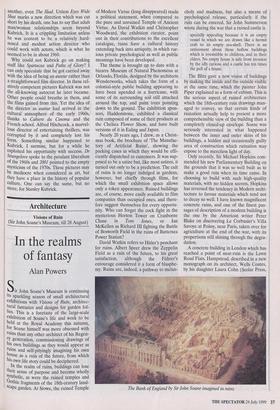Architecture
Visions of Ruin (Sir John Soane's Museum, till 28 August)
In the realms of fantasy
Alan Powers
Sit John Soane's Museum is continuing its sparkling season of small architectural exhibitions with Visions of Ruin, architec- tural fantasies and designs for garden fol- lies. This is a foretaste of the large-scale exhibition of Soane's life and work to be held at the Royal Academy this autumn, for Soane himself was more obsessed with ruins than any other architect of his Regen- cy generation, commissioning drawings of his own buildings as they would appear as rums and self-pityingly imagining his own house as a ruin of the future, from which his own life story could be deciphered. In the realm of ruins, buildings can lose their sense of purpose and become wholly sYMbolic as were the ruined temples and Gothic fragments of the 18th-century land- scape garden. At Stowe, the ruined Temple of Modern Virtue (long disappeared) made a political statement, when compared to the pure and unruined Temple of Ancient Virtue. As David Watkin and Christopher Woodward, the exhibition curator, point out in their contributions to the excellent catalogue, ruins have a cultural history extending back into antiquity, in which var- ious private psychological as well as public meanings have been developed.
The theme is brought up to date with a bizarre Museum of Natural Phenomena at Orlando, Florida, designed by the architects Wonderworks, which takes the form of a colonial-style public building appearing to have been upended in a hurricane, with some of its surrounding soil still attached around the top, and palm trees pointing down to the ground. The exhibition spon- sors, Haddonstone, exhibited a classical ruin composed of some of their products at the Chelsea Flower Show, and have built versions of it in Ealing and Japan.
Nearly 20 years ago, I drew, as a Christ- mas book, the brochure of 'The Manufac- tory of Artificial Ruins', showing the packing cases in which they would be effi- ciently dispatched to customers. It was sup- posed to be a satire but, like most satires, it turned out only to be a prediction. The cult of ruins is no longer indulged in gardens, however, but chiefly through films, for which the small exhibition space allows only a token appearance. Ruined buildings are, of course, more easily available to film companies than occupied ones, and there- fore suggest themselves for every opportu- nity. Who can forget the cock fight in the mysterious Horton Tower on Cranborne Chase in Tom Jones, or Ian McKellen as Richard III fighting the Battle of Bosworth Field in the ruins of Battersea Power Station?
David Watkin refers to Hitler's penchant for ruins. Albert Speer drew the Zeppelin Field as a ruin of the future, to his great satisfaction, although the Fiihrer's entourage considered it a form of blasphe- my. Ruins are, indeed, a pathway to melan- choly and madness, but also a means of psychological release, particularly if the ruin can be entered. Sir John Summerson wrote during the war that a ruined castle is specially appealing because it is an empty vessel to which we are drawn like a hermit crab to an empty sea-shell. There is an enticement about these hollow buildings which is irresistible to children, and to their elders. No empty house is safe from invasion by the idly curious and a castle has ten times the pull of a house.
The Blitz gave a new vision of buildings by making the inside and the outside visible at the same time, which the painter John Piper explained as a form of cubism. This is the serious aspect of ruined architecture which the 18th-century ruin drawings man- aged to convey, so that certain kinds of ruination actually help to present a more comprehensible view of the building than a completely closed-up envelope. Soane was seriously interested in what happened between the inner and outer skins of his buildings, a hidden and occasionally guilty area of construction which ruination may expose to the merciless light of day.
Only recently, Sir Michael Hopkins com- mended his new Parliamentary Building on the grounds that it was so well built as to make a good ruin when its time came. In choosing to build with such high-quality materials, with no hidden secrets, Hopkins has reversed the tendency in Modern archi- tecture to favour materials which tend not to decay so well. I have known magnificent concrete ruins, and one of the finest pas- sages of description of a modern building is the one by the American writer Peter Blake on discovering Le Corbusier's Villa Savoye at Poissy, near Paris, taken over for agriculture at the end of the war, with its proportions still shining through the degra- dation.
A concrete building in London which has reached a point of near-ruin is the Lawn Road Flats, Hampstead, described in a new monograph on its architect, Wells Coates, by his daughter Laura Cohn (Scolar Press, The Bank of England by Sir John Soane imagined in ruins £25). This famous building, scene of much of the invention of British Modernism in the 1930s, accompanied by strange and exotic food like Camembert ice-cream served by the resident chef, Philip Harben, fell into the hands of Camden Council and entered a downward spiral over the course of 30 years. It is now to be sold, and its ruination will, one hopes, be reversed, although it has its poignancy as a memento mori of unfulfilled hopes for the improve- ment of the world.



























































 Previous page
Previous page